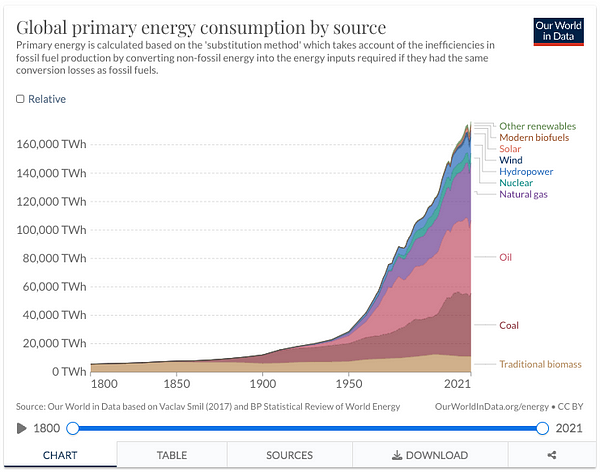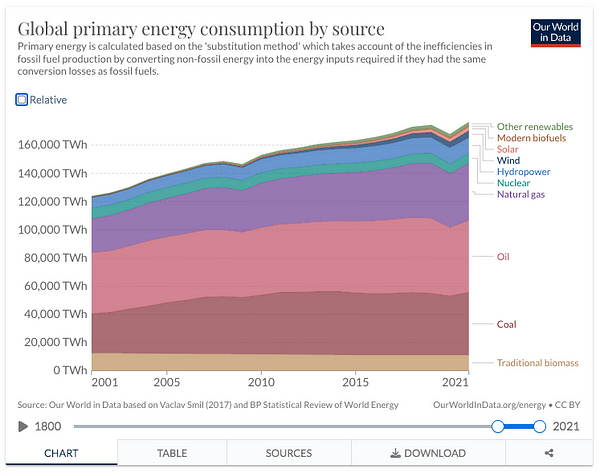Today’s Contemplation: Collapse Cometh LXXXV
December 21, 2022 (original posting date)

Energy Future, Part 1
A short introductory contemplation to a multipart one on our energy future[1].
It’s difficult to make predictions, especially about the future.
-various attributions (e.g., Niels Bohr, Yogi Berra, Mark Twain)
Energy[2]. It is the fundamental component necessary for all physical, chemical, and biological processes. So life…hell, the universe appears impossible without it[3].
While all forms of energy are ultimately important to human life, it is the bioenergetic and food energy aspects that are perhaps most salient[4]. For human complex societies that require energy inputs to ‘power’/support the organisational structures that help to create and sustain our varied and numerous complexities, it is the transformation of various energy sources into ‘usable’ forms that is vital[5].
As Vaclav Smil writes at the beginning of his 2017 text, Energy and Civilization: A History:
“Energy is the only universal currency: one of its many forms must be transformed to get anything done. Universal manifestations of these transformations range from the enormous rotations of galaxies to thermo- nuclear reactions in stars. On Earth they range from the terra-forming forces of plate tectonics that part ocean floors and raise new mountain ranges to the cumulative erosive impacts of tiny raindrops (as the Romans knew, gutta cavat lapidem non vi, sed saepe cadendo — A drop of water hollows a stone not by force but by continually dripping). Life on Earth — despite decades of attempts to catch a meaningful extraterrestrial signal, still the only life in the universe we know of — would be impossible without the photosynthetic conversion of solar energy into phytomass (plant biomass). Humans depend on this transformation for their survival, and on many more energy flows for their civilized existence. As Richard Adams (1982, 27) put it,
We can think thoughts wildly, but if we do not have the wherewithal to convert them into action, they will remain thoughts. … History acts in unpredictable ways. Events in history, however, necessarily take on a structure or organization that must accord with their energetic components.
The evolution of human societies has resulted in larger populations, a growing complexity of social and productive arrangements, and a higher quality of life for a growing number of people. From a fundamental biophysical perspective, both prehistoric human evolution and the course of history can be seen as the quest for controlling greater stores and flows of more concentrated and more versatile forms of energy and converting them, in more affordable ways at lower costs and with higher efficiencies, into heat, light, and motion.”
In this energy-transforming quest, fossil fuels have become the most critical and fundamental energy source to our modern, industrialised and exceedingly complex global society. As can be seen in the graph below, it is estimated that fossil fuel-based energy (i.e., coal, oil, and natural gas) is responsible for 80+% of our current energy needs that support our many varied complexities from transportation and food production to industrial production and communications.

Evidence suggests there is no current substitute — at density or scale — for the energy provided by fossil fuels[6]. We continue to be exposed to countless promises and potential technological ‘breakthroughs’ to replace them (especially when it comes to ‘clean/green’ energy sources, or should I say non-renewable, renewable energy-harvesting technologies), but the cold hard fact is that our dependence upon fossil fuels continues and is actually increasing, even when one zooms in on the past twenty years when ‘renewables’ have been pursued with ‘gusto’ as shown in the following graph (although not as much fervor as some would like and argue for — ignoring/rationalising away the ecological systems destruction that would accompany such a ‘war effort-like’ push).

All of the ‘renewables’ we have adopted have been additive to our fossil fuel dependency. They have not supplanted any — or at least minimally — fossil fuel extraction or use[7]. In fact, it could be argued that they have increased it due to their dependency upon fossil fuel-based industrial processes[8].
Add to this that there is convincing evidence that we have encountered significant diminishing returns in our extraction of fossil fuels[9]. This can be seen in our need to increase continually the energy and resource inputs towards accessing and extracting these fuels (e.g., deep sea drilling, hydraulic fracturing, bitumen refinement).
This necessity necessarily has an impact on the net energy that we have for supporting our complexities. We are increasingly having to put more and more energy/resources into fossil fuel extraction and refinement resulting in less and less energy/resources leftover to maintain our complex systems, let alone have any leftover to pursue growth as we have the past century or more[10].
So, we have a finite resource that is requiring greater energy/resource inputs to access and retrieve but that we depend significantly upon with no comparable replacement — to say little about the ecological systems destruction accompanying all of this (‘renewables’ and fossil fuels alike).
This is an obvious conundrum. Where do we go from here is what a number of people want to know…and I will explore this further in Part 2.
[1] Please note that I am not an ‘expert/academic/researcher/etc.’ in the topics discussed but an avid ‘student’ of them as I try to make sense of how and why events are unfolding the way they are. This is why I have included quite a number of references (to those who may be considered ‘experts) to my thoughts. Declaring this, I am also wary of the term ‘expert’ in light of criticisms such as those expressed by Philip Tetlock, Nicholas Nassim Taleb, and others: see this, this, this, this, and/or this. The views expressed, therefore, are part of my personal journey of understanding; they could be accurate but they might not be…in the end, I believe we all believe what we want to believe.
[3] See this, this, this, this, and/or this.
[5] See this, this, this, this, this, this, this, and/or this.
[6] See this, this, this, and/or this.
[7] See this, this, this, this, and/or this.
[8] See this, this, and/or this.
[9] See this, this, this, this, this, this, this, and/or this.